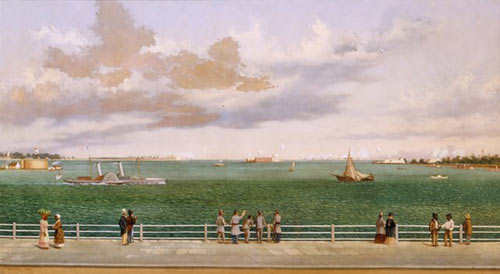It has been my pleasure for the past month to intern with the Gibbes’ Programs, Events, and Marketing department. I assisted in writing social media posts, responding to donation requests, documenting press and brainstorming ways to publicize the upcoming exhibit, Photography and the American Civil War, (which of course I will plug here) opening September 27th.
I was thrilled to have been offered the position. It has always been a favorite pastime of mine to spend hours wandering through galleries, sometimes in search of a particular work but often aimlessly, soaking in the history. I have traveled to cities for the sole purpose of catching an alluring exhibition, and have a bucket list of museums that I would like to see. I hold on to my ticket stubs and write any significant works on the back, so that I can recall the experience in the future. To me, a visit to a museum is a cathartic experience that we can collectively enjoy. Much of the modern world has access to museums, and the privilege of plumbing our history in the comfort of a quiet, air-conditioned building.
Each museum has a different flow and architectural structure; the organic spiral of the Guggenheim Museum in NYC creates a totally different atmosphere from the soon-to-be-renovated Beaux-Arts style of the Gibbes. Each museum has a unique collection; I was amazed to find out that the Gibbes over 10,000 objects, including paintings, sculpture, photographs, and archival materials. Every museum boasts an individual mission statement—their purpose for keeping the lights on. However while the intent of the Smithsonian may not be identical to that of the Gibbes, all museums serve the same general purpose: to preserve the vestiges of human existence.
But what distinguishes an art museum from a museum of history? While history museums hold primary documents, ephemera, tangible facts if you will, art museums tell a different story. The Gibbes and institutions like it hold items that speak of our interpretation of a time in history, and how we use art as a tool to remember. As I have been learning more about the Civil War and exploring the collection catalogue, I have been thinking about how we have use photography for the sake of documentation. Dorothea Lange said it best, “Photography takes an instant out of time, altering life by holding it still.” As time continues to pass since “our nations bloodiest war,” the war between the states, our memory of it will continue to be informed by what was left behind.
![[President Abraham Lincoln, Major General John A. McClernand and E. J. Allen (Allan Pinkerton)], 1862, by Alexander Gardner (American, Glasgow, Scotland 1821–1882 Washington, D.C.)](https://www.gibbesmuseum.org/wp-content/uploads/2013/09/Abraham-Lincoln_Mathew-Brady.jpg)

The exhibit is traveling all the way from the Metropolitan Museum of Art in New York, and I could not think of a more suitable place for it to be held than Charleston, home to several important sites of action in the Civil War. In fact, we recently passed the 150th anniversary of the Union’s attempt to storm Fort Sumter. I am a proud Charlestonian, and I am proud to have played a small part in the promotion of this highly anticipated exhibition.
—Annie Stoppelbein, Public Programs & Marketing Intern and guest blogger
Published September 20, 2013

